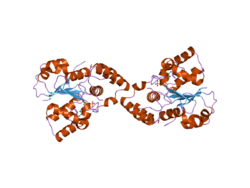SULT1C3
| SULT1C3 | |||||||||||||||||
|---|---|---|---|---|---|---|---|---|---|---|---|---|---|---|---|---|---|
 |
|||||||||||||||||
| |||||||||||||||||
| Identifiers | |||||||||||||||||
| Aliases | SULT1C3, ST1C3, sulfotransferase family 1C member 3 | ||||||||||||||||
| External IDs | MGI: 102928 HomoloGene: 56817 GeneCards: SULT1C3 | ||||||||||||||||
| |||||||||||||||||
| Orthologs | |||||||||||||||||
| Species | Human | Mouse | |||||||||||||||
| Entrez | |||||||||||||||||
| Ensembl | |||||||||||||||||
| UniProt | |||||||||||||||||
| RefSeq (mRNA) | |||||||||||||||||
| RefSeq (protein) | |||||||||||||||||
| Location (UCSC) | Chr 2: 108.25 – 108.27 Mb | Chr 17: 53.96 – 53.99 Mb | |||||||||||||||
| PubMed search | [1] | [2] | |||||||||||||||
| Wikidata | |||||||||||||||||
| View/Edit Human | View/Edit Mouse |
Sulfotransferase 1C3, also known as ST1C3, is an enzyme that in humans is encoded by the SULT1C3 gene.[3][4][5]
Function
Sulfotransferase enzymes catalyze the sulfate conjugation of many hormones, neurotransmitters, drugs, and xenobiotic compounds. These cytosolic enzymes are different in their tissue distributions and substrate specificities. The gene structure (number and length of exons) is similar among family members.[3]
Clinical significance
ST1C3 sulfates large benzylic alcohols such as 1-hydroxymethyl-pyrene to chemically reactive mutagenic sulpho conjugates.[6]
See also
References
- ↑ "Human PubMed Reference:".
- ↑ "Mouse PubMed Reference:".
- 1 2 "Entrez Gene: sulfotransferase family".
- ↑ Freimuth RR, Wiepert M, Chute CG, Wieben ED, Weinshilboum RM (2004). "Human cytosolic sulfotransferase database mining: identification of seven novel genes and pseudogenes". Pharmacogenomics J. 4 (1): 54–65. doi:10.1038/sj.tpj.6500223. PMID 14676822.
- ↑ Allali-Hassani A, Pan PW, Dombrovski L, Najmanovich R, Tempel W, Dong A, Loppnau P, Martin F, Thornton J, Thonton J, Edwards AM, Bochkarev A, Plotnikov AN, Vedadi M, Arrowsmith CH (May 2007). "Structural and chemical profiling of the human cytosolic sulfotransferases". PLoS Biol. 5 (5): e97. doi:10.1371/journal.pbio.0050097. PMC 1847840
 . PMID 17425406.
. PMID 17425406. - ↑ Meinl W, Donath C, Schneider H, Sommer Y, Glatt H (April 2008). "SULT1C3, an orphan sequence of the human genome, encodes an enzyme activating various promutagens". Food Chem. Toxicol. 46 (4): 1249–56. doi:10.1016/j.fct.2007.08.040. PMID 17936463.
This article is issued from Wikipedia - version of the 6/3/2016. The text is available under the Creative Commons Attribution/Share Alike but additional terms may apply for the media files.